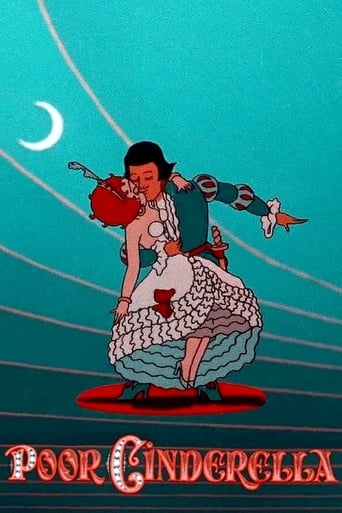Horst in Translation ([email protected])
"Poor Cinderella" is a 10.5-minute animated short film from 1934, so it had its 80 anniversary two years ago and it is one of the longest Betty Boop cartoons. There is one crucial difference here compared to her usual work: This one is in color. And this is also the main reason why it makes such an impact. I do believe color usually adds a lot to fairy-tale based movie and the title already gives away that this is the Fleischer Studios' take on the famous Cinderella story. You all know the plot, so I won't go a lot into detail here. Of course, at this runtime, they had to shorten it considerably in terms of certain plot elements. The evil mother of the two not-so-attractive girls is missing entirely and she is the main antagonist in the tale usually. Betty as Cinderella works very well and once again the male audience members will like that you see Betty in underwear on one occasions. They certainly play with her sex appeal, not just in this one. And who would have guessed that Betty shows up as a redhead in her most-known color movie. I recommend the watch. Different, but pretty good for a Betty Boop film and one of my favorites.
Richard Rothenberg
Max & Dave Fleischer & co. were among the very best of the creators of novel and surprising applications of animation from the late teens through the entire decade of the 1930's. For "Poor Cinderella", they must have noted Disney's stunning "Flowers And Trees", produced in 1931 and released the following year. The latter is generally credited as being the first full color process American cartoon, as opposed to two strip color which emphasized either blues or greens at the expense of certain shades that were lost to the lesser and less costly techniques of the day. For budgetary reasons, the ever inventive Fleischer Bros. developed their own "Cinecolor" approach, which was a variant on the two-strip color format. Although it apparently never quite caught on, they had applied for a patent while releasing their astoundingly beautiful and hysterically surreal and laugh-laden Boop masterpiece in 1934, the only Betty Boop color cartoon. Combining their proprietary Rotoscope technique along with other dimension enhancing toolkit tricks, few cartoon shorts have ever matched this effort for sheer entertainment value. They did try saving money on the color, as mentioned, but the whole production was obviously a very expensive endeavor, when all its components are considered in sum. The results offer a lasting tribute to the art and magic of 1930's animation. As a Depression-era vehicle, good jobs were scarce but the Fleischer team's uproarious talent sported young and brash animators who were willing to push the envelope of sensibilities and censors alike, much to our delight. Even the closing sequence is incredibly absurd, and gems like this will forever prevail.Betty had already helped launch the Popeye series a year earlier, so by 1934 the Fleischers had their distinctly urban stamp firmly planted under two cartoon banners aimed as much, if not more, at adults as the kids. If that weren't true, they wouldn't have always had to play "duck and cover" with the ever-present Hays commission, censor gavel at the ready. Thanks to the Fleischer folks and all involved parties, for the guts, the creative ambition, the sheer genius, and the uncompromising quality of whichever production standards were chosen to collectively coalesce into a cartoon gem for the ages. This is a must see.
Son_of_Mansfield
Betty Boop, fetching even in rags, meets her prince thanks to her fairy godmother. Similar elements of the movie are here, but the short stands in it's own. There are wicked stepsisters, but no stepmother. The animation of the mice and lizards transforming to horses and coachmen is very reminiscent of the Disney movie. The music would fit in that movie, but adds to the short's charm. I really liked the Cupid who banged the prince on the head with a mallet when he first glimpsed Betty. The talking pumpkin is a little scary with it's jagged teeth and deep voice. The ending is happy of course with Betty reunited with her slipper and her prince. While this short can't match that movie's completeness and gloss, this is a very enjoyable short for lovers of the classic story. This is the only color Betty Boop cartoon that I have seen and hopefully not the only one in existence.
Popeye-8
Before moving on to their prolific (and highly successful) POPEYE series (as well as into their unfortunate GABBY series--just imagine Elmer Fudd without his macho sex appeal), Paramount's Fleischer brothers poured their creative genius into BETTY BOOP. This is their finest B-B cartoon, and may just be their finest EVER, period.Using their 3-D filming process (and a unheard-of budget for a cartoon short), they adapted the Cinderella legend to Betty, adding some marvelous songs and (likely roto-scoped) beautiful dance numbers. For reasons not told, this was the only Betty Boop cartoon ever done in color--a tragedy.Look for versions with the original opening titles intact--even the titles show that this was a project of love (and yes, money). Plus, Betty's as sexy an ingenue as ever thanks to Technicolor.
